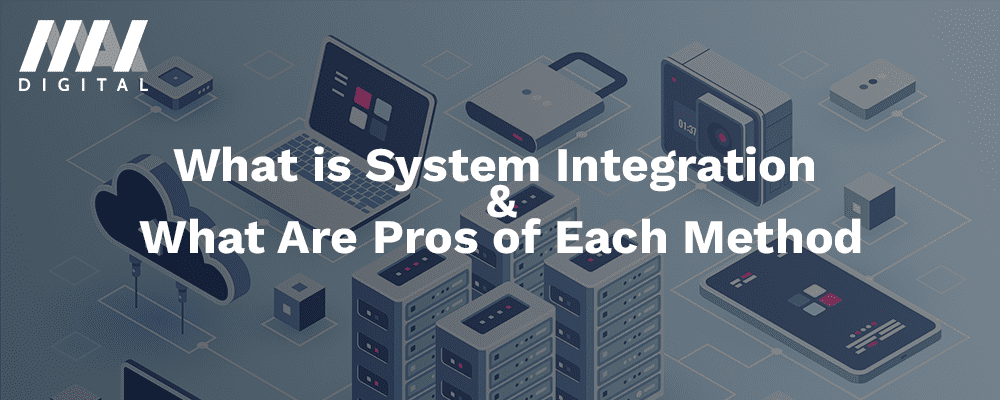What is System Integration and What Are Pros of Each Method

System integration is an automatic data management process that allows multiple systems to interact by sharing information between them seamlessly. Instead of manually developing a means to send data between two or more individual software with different programming languages, a system integrator serves as a connector between them to automatically share data. System integration ensures that partners, suppliers, and customers use software without worrying about how the software will get data from third-party software that their software depends on.
Companies also build system integrations to connect multiple custom software systems within the organization to foster productivity. API is one of the most popular system integrations available, but it can’t solve every system integration problem. Businesses need to learn about different system integration methods. So, we will discuss some system integrations and the problems they can solve.
System Integration Methods
Application Programming Interface (API)
API is a code-based system integration method that can connect multiple applications. It can be private or public or for partners like the one Google Maps offers its partners. An organization can create a custom API to interact with some of its custom systems to improve productivity.
Pros
- Easy integration: most suppliers automatically share their API code with partners and clients upon purchase of their services/solutions or when the partnership starts. Some suppliers make their API public even so that anyone who finds a need for it can use it without reaching out to them.
- APIs are available: you will find an API for almost any software solution. The fintech industry, for one, depends on APIs to give their customers robust financial offerings, especially in the payment solutions area.
- Data Control: APIs give clients and partners data control that allows them to make changes to data.
Cons
- Code-based: you need to have code knowledge to use an API because you will still code the API into your system.
- Dependence on supplier: API is commonly used by third parties; the API supplier is an external party, while the clients or partners that use the API are separate entities. The API supplier has to schedule a time to code relevant updates into the API. Hence, clients and partners who use the API will have to wait and depend on the supplier for updates and data access.
HTTP Callbacks, aka Webhooks
Webhook is an event-based feature built into web applications and systems that triggers a callback once a particular event occurs and reaches for relevant data to share with the endpoints. An endpoint, in this context, is a third-party web-based system or application that calls out data on another system (supplier).
Pros
- Real-time access:unlike APIs, a webhook feature gives endpoints real-time access to data on the supplier system, so clients and partners don’t have to wait for the supplier to release third-party updates. They will also receive the latest data available on the system upon request to the supplier system.
Cons
- Limited control:Webhook is a simple system integration method with limited functionality that depends on event triggers to share data with endpoints. It is also a one-way data management process because endpoints can’t make any changes but can only access data.
Customer Relationship Management (CRM)
CRM is a system integration that fosters the transmission of customer data within subsystems to give the ecosystem real-time access to all customer data. It can be custom-built or subscription-based as offered by SaaS CRM providers. CRMs enable different departments within the same organization to access updated customer data.
Pros
- Automation: CRMs help with the repetitive processes of managing customer relationships.
- Fosters collaboration: medium to large businesses with thousands of customers will benefit from a CRM because it enables easy collaboration within different departments in the organization, which gives customers full customer service.
Cons
- Expensive: small businesses may see CRMs as an unnecessary expense they can avoid if employees communicate with each other. Not to mention that organizations can create a database of customer data on spreadsheets.
- Data entry: someone or some people have to be responsible for storing customer data in the CRM so that other departments can access and use it. Sometimes, this can be tedious, although it depends on the CRM.
Integration Services Components (ISC)
ISC is a system integration method that allows subsystems to access data when connected to a live server given that the organization has back-end access to the supplier system.
Pros
- Easy functionality: ISC only requires cloud access to the supplier system, and the ISC will automatically collect data from the supplier when needed.
Cons
- Requires back-end access to supplier system: ISC won’t work without cloud access to the supplier system, and most organizations don’t give out cloud access to their data server.
Orchestration
orchestration is a custom-built code-based system integration that uses automation to share data between multiple subsystems. Orchestration is mainly used for repetitive processes to reduce human input by automating multiple software systems to access data and schedule tasks.
Pros
- Central management: because all the subsystems are connected, the IT can manage all automated processes simultaneously, thereby reducing security risks. It also increases transparency within the organization.
Cons
- Code-based: Orchestration requires coding knowledge since you have to create code for automated scheduling within multiple systems. Not to mention the amount of human input required to manage the scheduling of tasks within multiple systems.
Vertical Integration (Silo)
This method links functionally related subsystems in a silo structure, from bottom to top. The subsystem with the simplest functionality bottom occupies the bottom position, and the silo structure progresses upwards based on the functionality difficulty each subsystem performs.
Pros
- Reduced risk: because of the functional proximity of the subsystems that share a structure, it gives you more control which reduces risk.
Cons
- Inflexible: adding a new system to a vertical integration structure can be difficult because it requires you to build its silo structure, and you get to repeat the process each time you add a new system.
Enterprise Service Bus (ESB), aka Horizontal Integration
Horizontal integration method uses an intermediary connector known as enterprise service bus (ESB) to connect multiple subsystems to the same single interface layer. All systems connect to the same ESB to collect and share data with other systems in the integration.
Pros
- Reduced connections: since all the systems in the integration structure only connect to the ESB, it eliminates the need for each subsystem to directly connect to other subsystems, which reduces the number of connections.
- High scalability: because each subsystem directly connects to the ESB, the organization can disconnect any subsystem without affecting the other subsystems on the ESB.
Cons
- Maintenance difficulty: because each connection ties to an individual subsystem, you can’t run unified troubleshooting across all subsystems simultaneously.

 1-888-553-8776
1-888-553-8776
